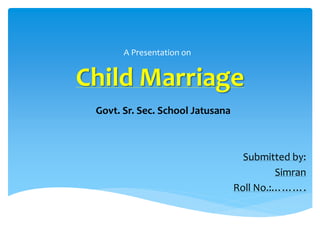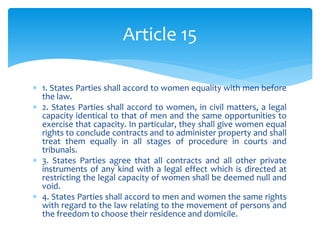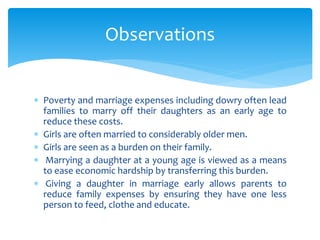Child marriage
- 1. GSSS JATUSANA Welcome to Block Level Competition of Legal Literacy Date: 21 Janurary, 2021
- 2. Child Marriage A Presentation on Govt. Sr. Sec. School Jatusana Submitted by: Simran Roll No.:……….
- 3. A person who, if a male, has not completed twenty one years of age and, if a female has not completed eighteen years of age. A Child….?
- 4. According to UNICEF, child marriage is a formal or informal union before the age of 18. What is Child Marriage?
- 5. A. India has the highest percentage of child brides in the world. About 47% of the girls get married before reaching the age of 18. B. 2011 Census data showed that 91% of all women were married by 25 years of age with an alarming rate of 30.2% girls who were married before the age of 18. Statics in India
- 6. 1. States Parties shall accord to women equality with men before the law. 2. States Parties shall accord to women, in civil matters, a legal capacity identical to that of men and the same opportunities to exercise that capacity. In particular, they shall give women equal rights to conclude contracts and to administer property and shall treat them equally in all stages of procedure in courts and tribunals. 3. States Parties agree that all contracts and all other private instruments of any kind with a legal effect which is directed at restricting the legal capacity of women shall be deemed null and void. 4. States Parties shall accord to men and women the same rights with regard to the law relating to the movement of persons and the freedom to choose their residence and domicile. Article 15
- 7. The betrothal and the marriage of a child shall have no legal effect and all necessary action including legislation shall be taken to specify a minimum age for marriage and to make the registration of marriage in an official registry compulsory. Article 16 (2)
- 8. Poverty and marriage expenses including dowry often lead families to marry off their daughters as an early age to reduce these costs. Girls are often married to considerably older men. Girls are seen as a burden on their family. Marrying a daughter at a young age is viewed as a means to ease economic hardship by transferring this burden. Giving a daughter in marriage early allows parents to reduce family expenses by ensuring they have one less person to feed, clothe and educate. Observations
- 9. 1. Poverty 2. Economic survival strategies 3. Gender Inequality 4. Sealing (confirming) land or property deals 5. Settling disputes 6. Control over sexuality and family honour 7. Tradition and culture 8. Insecurity, especially during wars, droughts, famines or epidemics Causes of Child Marriage
- 10. Early Pregnancy-Health complications Fall in High Fertility Age Group Inabilities to Plan or Manage Families Effect on sexual health of young girls Desire for Male Child High difference in age between bride and bridegroom Effects of Child Marriage
- 11. Offenders under section 10 and/or 11 could include; The guardians/parents of both the parties Priests, relatives and friends of both parties Neighbours of both parties Community leaders who give patronage to such marriages Marriage bureaus/persons responsible for fixing such marriages Traffickers The bridegroom, if over 18 Caterers and other service providers Offenders
- 12. A court having jurisdiction over matters involving divorce, child custody and support, paternity, domestic violence and other family-law issues. Family Courts
- 13. The Child Marriage Restraint Act of 1929 The Prohibition of Child Marriage Act of 2006 Hindu Marriage Act, 1956 Muslim Personal Law Indian Christian Marriage Act (ICMA) Laws for Child Marriage
- 14. The Convention on The Elimination of All Forms of Discrimination against Women (CEDAW) is an International bill attempting to end discrimination against women. This convention states that child marriages should not have a legal effect and all legal actions must be taken to enforce a minimum age, and that all marriages must be put into an official registry. India signed this convention on July 30, 1980 but stated a declaration that because of the nation’s size and increasing population, it is impractical to register all marriages of the country. CEDAW














